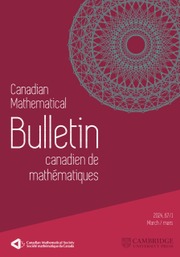No CrossRef data available.
Article contents
Krivine’s Function Calculus and Bochner Integration
Published online by Cambridge University Press: 15 October 2018
Abstract
We prove that Krivine’s Function Calculus is compatible with integration. Let  $(\unicode[STIX]{x1D6FA},\unicode[STIX]{x1D6F4},\unicode[STIX]{x1D707})$ be a finite measure space,
$(\unicode[STIX]{x1D6FA},\unicode[STIX]{x1D6F4},\unicode[STIX]{x1D707})$ be a finite measure space,  $X$ a Banach lattice,
$X$ a Banach lattice,  $\mathbf{x}\in X^{n}$, and
$\mathbf{x}\in X^{n}$, and  $f:\mathbb{R}^{n}\times \unicode[STIX]{x1D6FA}\rightarrow \mathbb{R}$ a function such that
$f:\mathbb{R}^{n}\times \unicode[STIX]{x1D6FA}\rightarrow \mathbb{R}$ a function such that  $f(\cdot ,\unicode[STIX]{x1D714})$ is continuous and positively homogeneous for every
$f(\cdot ,\unicode[STIX]{x1D714})$ is continuous and positively homogeneous for every  $\unicode[STIX]{x1D714}\in \unicode[STIX]{x1D6FA}$, and
$\unicode[STIX]{x1D714}\in \unicode[STIX]{x1D6FA}$, and  $f(\mathbf{s},\cdot )$ is integrable for every
$f(\mathbf{s},\cdot )$ is integrable for every  $\mathbf{s}\in \mathbb{R}^{n}$. Put
$\mathbf{s}\in \mathbb{R}^{n}$. Put  $F(\mathbf{s})=\int f(\mathbf{s},\unicode[STIX]{x1D714})\,d\unicode[STIX]{x1D707}(\unicode[STIX]{x1D714})$ and define
$F(\mathbf{s})=\int f(\mathbf{s},\unicode[STIX]{x1D714})\,d\unicode[STIX]{x1D707}(\unicode[STIX]{x1D714})$ and define  $F(\mathbf{x})$ and
$F(\mathbf{x})$ and  $f(\mathbf{x},\unicode[STIX]{x1D714})$ via Krivine’s Function Calculus. We prove that under certain natural assumptions
$f(\mathbf{x},\unicode[STIX]{x1D714})$ via Krivine’s Function Calculus. We prove that under certain natural assumptions  $F(\mathbf{x})=\int f(\mathbf{x},\unicode[STIX]{x1D714})\,d\unicode[STIX]{x1D707}(\unicode[STIX]{x1D714})$, where the right hand side is a Bochner integral.
$F(\mathbf{x})=\int f(\mathbf{x},\unicode[STIX]{x1D714})\,d\unicode[STIX]{x1D707}(\unicode[STIX]{x1D714})$, where the right hand side is a Bochner integral.
MSC classification
Information
- Type
- Article
- Information
- Copyright
- © Canadian Mathematical Society 2018
Footnotes
The first author was supported by an NSERC grant.

